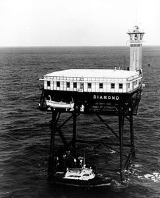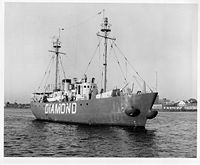
Diamond Shoal Light
Encyclopedia
Diamond Shoal Light was an off-shore lighthouse
marking Diamond Shoals off Cape Hatteras
.
, is considered to be one of the most dangerous spots on the Atlantic seaboard. While a light was exhibited from the cape itself from 1804, its range was insufficient, and a lightship
was stationed on the shoal itself in 1824. It was driven off station numerous times, eventually being wrecked near Ocracoke Inlet in 1827. Various buoy
s were placed beginning in 1852, but all were short-lived.
In 1889 congress
authorized construction of a permanent lighthouse on the shoal, at a cost not to exceed $500,000. The firm of Anderson & Barr, which had constructed the Fourteen Foot Bank Light
in Delaware Bay
in 1885-1887, was awarded the contract. A caisson
was constructed in Norfolk, Virginia
and towed to the site in June 1891. It was sunk into the shoal on July 1 and immediately began to tilt due to the sandy bottom and severe scour by the currents. Addition of iron plates at the top of the structure merely succeeded in keeping it marginally above water. A storm on July 4 drove the work crews away and destroyed the structure. Anderson, who supervised the construction, later claimed that the problem was exacerbated by out of date charts with inaccurate soundings. In any case, construction was abandoned, and $79,000 of the original appropriation was diverted to the construction of a lightship to replace the failed tower.
 That lightship, LV 69, was the first of six lightships employed at Diamond Shoals in the twentieth century. Prior to World War I
That lightship, LV 69, was the first of six lightships employed at Diamond Shoals in the twentieth century. Prior to World War I
, lightships were assigned in pairs at this station, which each relieving the other; after LV 71 was sunk by the German submarine U-104, a single ship was assigned, relieved as needed. During World War II
the lightship was replaced by a lighted buoy. The last lightship stationed here, WLV 189, was the first lightship built after the Coast Guard
took over the Lighthouse Service, and the first all-welded lightship; it was expressly built for service at this station, and remained in service there until 1966.
In the early 1960s, "Texas Tower
" lighthouses were erected at six offshore sites on the East coast. Diamond Shoals was the second to last to be built, and was activated in 1966; it was automated in 1977. The unmanned lighthouse suffered significant damage from Hurricane Fran
in 1996, and the catwalks were subsequently found to be so rotten that the light could only be safely visited by helicopter. The light was extinguished in 2001, and has since been removed.
Although the light was removed, the tower still stands and is frequented by fishermen for the many species of fish that live below and near it. Amberjack and barracuda are some of the larger fish that call Diamond Shoals light tower their home.
Lighthouse
A lighthouse is a tower, building, or other type of structure designed to emit light from a system of lamps and lenses or, in older times, from a fire, and used as an aid to navigation for maritime pilots at sea or on inland waterways....
marking Diamond Shoals off Cape Hatteras
Cape Hatteras
Cape Hatteras is a cape on the coast of North Carolina. It is the point that protrudes the farthest to the southeast along the northeast-to-southwest line of the Atlantic coast of North America...
.
History
Diamond Shoals, which extend many miles out from Cape HatterasCape Hatteras
Cape Hatteras is a cape on the coast of North Carolina. It is the point that protrudes the farthest to the southeast along the northeast-to-southwest line of the Atlantic coast of North America...
, is considered to be one of the most dangerous spots on the Atlantic seaboard. While a light was exhibited from the cape itself from 1804, its range was insufficient, and a lightship
Lightvessel
A lightvessel, or lightship, is a ship which acts as a lighthouse. They are used in waters that are too deep or otherwise unsuitable for lighthouse construction...
was stationed on the shoal itself in 1824. It was driven off station numerous times, eventually being wrecked near Ocracoke Inlet in 1827. Various buoy
Buoy
A buoy is a floating device that can have many different purposes. It can be anchored or allowed to drift. The word, of Old French or Middle Dutch origin, is now most commonly in UK English, although some orthoepists have traditionally prescribed the pronunciation...
s were placed beginning in 1852, but all were short-lived.
In 1889 congress
United States Congress
The United States Congress is the bicameral legislature of the federal government of the United States, consisting of the Senate and the House of Representatives. The Congress meets in the United States Capitol in Washington, D.C....
authorized construction of a permanent lighthouse on the shoal, at a cost not to exceed $500,000. The firm of Anderson & Barr, which had constructed the Fourteen Foot Bank Light
Fourteen Foot Bank Light
Fourteen Foot Bank Light is a lighthouse in Delaware, United States, in the Delaware Bay near Bowers Beach. Built in 1885-1886 at the south end of Joe Flogger Shoal, it was the first lighthouse to be built using a pneumatic caisson. The wooden caisson structure was excavated to a depth of below...
in Delaware Bay
Delaware Bay
Delaware Bay is a major estuary outlet of the Delaware River on the Northeast seaboard of the United States whose fresh water mixes for many miles with the waters of the Atlantic Ocean. It is in area. The bay is bordered by the State of New Jersey and the State of Delaware...
in 1885-1887, was awarded the contract. A caisson
Caisson (engineering)
In geotechnical engineering, a caisson is a retaining, watertight structure used, for example, to work on the foundations of a bridge pier, for the construction of a concrete dam, or for the repair of ships. These are constructed such that the water can be pumped out, keeping the working...
was constructed in Norfolk, Virginia
Norfolk, Virginia
Norfolk is an independent city in the Commonwealth of Virginia in the United States. With a population of 242,803 as of the 2010 Census, it is Virginia's second-largest city behind neighboring Virginia Beach....
and towed to the site in June 1891. It was sunk into the shoal on July 1 and immediately began to tilt due to the sandy bottom and severe scour by the currents. Addition of iron plates at the top of the structure merely succeeded in keeping it marginally above water. A storm on July 4 drove the work crews away and destroyed the structure. Anderson, who supervised the construction, later claimed that the problem was exacerbated by out of date charts with inaccurate soundings. In any case, construction was abandoned, and $79,000 of the original appropriation was diverted to the construction of a lightship to replace the failed tower.

World War I
World War I , which was predominantly called the World War or the Great War from its occurrence until 1939, and the First World War or World War I thereafter, was a major war centred in Europe that began on 28 July 1914 and lasted until 11 November 1918...
, lightships were assigned in pairs at this station, which each relieving the other; after LV 71 was sunk by the German submarine U-104, a single ship was assigned, relieved as needed. During World War II
World War II
World War II, or the Second World War , was a global conflict lasting from 1939 to 1945, involving most of the world's nations—including all of the great powers—eventually forming two opposing military alliances: the Allies and the Axis...
the lightship was replaced by a lighted buoy. The last lightship stationed here, WLV 189, was the first lightship built after the Coast Guard
United States Coast Guard
The United States Coast Guard is a branch of the United States Armed Forces and one of the seven U.S. uniformed services. The Coast Guard is a maritime, military, multi-mission service unique among the military branches for having a maritime law enforcement mission and a federal regulatory agency...
took over the Lighthouse Service, and the first all-welded lightship; it was expressly built for service at this station, and remained in service there until 1966.
In the early 1960s, "Texas Tower
Texas Tower (lighthouse)
A Texas Tower lighthouse is a structure, similar to an off-shore oil platform, used as a platform for a lighthouse.-Examples:The first example in the United States was the Buzzards Bay Light, located in Buzzards Bay, Massachusetts, and commissioned on November 1, 1961...
" lighthouses were erected at six offshore sites on the East coast. Diamond Shoals was the second to last to be built, and was activated in 1966; it was automated in 1977. The unmanned lighthouse suffered significant damage from Hurricane Fran
Hurricane Fran
Hurricane Fran was a powerful Cape Verde-type hurricane of the 1996 Atlantic hurricane season that made landfall near Cape Fear in North Carolina at Category 3 strength. Throughout the eastern United States, early statistics on Fran reported 27 deaths and $3.2 billion in damage...
in 1996, and the catwalks were subsequently found to be so rotten that the light could only be safely visited by helicopter. The light was extinguished in 2001, and has since been removed.
Although the light was removed, the tower still stands and is frequented by fishermen for the many species of fish that live below and near it. Amberjack and barracuda are some of the larger fish that call Diamond Shoals light tower their home.

